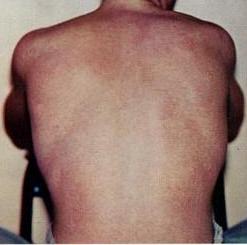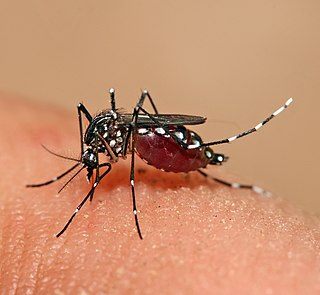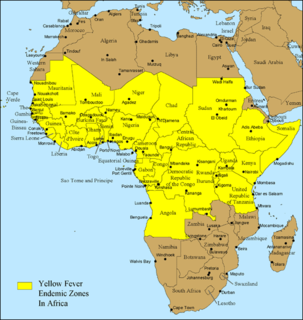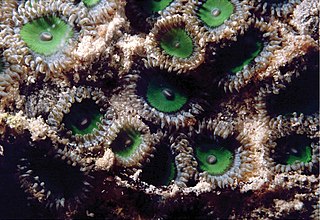
Dengue fever is a mosquito-borne tropical disease caused by the dengue virus. Symptoms typically begin three to fourteen days after infection. These may include a high fever, headache, vomiting, muscle and joint pains, and a characteristic skin rash. Recovery generally takes two to seven days. In a small proportion of cases, the disease develops into severe dengue, also known as dengue hemorrhagic fever, resulting in bleeding, low levels of blood platelets and blood plasma leakage, or into dengue shock syndrome, where dangerously low blood pressure occurs.

Aedes is a genus of mosquitoes originally found in tropical and subtropical zones, but now found on all continents except Antarctica. Some species have been spread by human activity: Aedes albopictus, a particularly invasive species, was recently spread to the New World, including the United States, by the used-tire trade.

Flavivirus is a genus of positive-strand RNA viruses in the family Flaviviridae. The genus includes the West Nile virus, dengue virus, tick-borne encephalitis virus, yellow fever virus, Zika virus and several other viruses which may cause encephalitis, as well as insect-specific flaviviruses (ISFs) such as cell fusing agent virus (CFAV), Palm Creek virus (PCV), and Parramatta River virus (PaRV). While dual-host flaviviruses can infect vertebrates as well as arthropods, insect-specific flaviviruses are restricted to their competent arthropods.

Dengue virus (DENV) is the cause of dengue fever. It is a mosquito-borne, single positive-stranded RNA virus of the family Flaviviridae; genus Flavivirus. Five serotypes of the virus have been found, all of which can cause the full spectrum of disease. Nevertheless, scientists' understanding of dengue virus may be simplistic, as rather than distinct antigenic groups, a continuum appears to exist. This same study identified 47 strains of dengue virus. Additionally, coinfection with and lack of rapid tests for zika virus and chikungunya complicate matters in real-world infections.

Palytoxin, PTX or PLTX is an intense vasoconstrictor, and is considered to be one of the most poisonous non-protein substances known, second only to maitotoxin in terms of toxicity in mice.
In the 2005 dengue outbreak in Singapore, a significant rise in the number of dengue fever cases was reported in Singapore, becoming the country's worst health crisis since the 2003 SARS epidemic. In October 2005, there were signs that the dengue fever outbreak had peaked, as the number of weekly cases had declined and the outbreak of this infectious disease declined by the end of 2005.

Zoanthids are an order of cnidarians commonly found in coral reefs, the deep sea and many other marine environments around the world. These animals come in a variety of different colonizing formations and in numerous colors. They can be found as individual polyps, attached by a fleshy stolon or a mat that can be created from small pieces of sediment, sand and rock. The term "zoanthid" refers to all animals within this order Zoantharia, and should not be confused with "Zoanthus", which is one genus within Zoantharia.

Antibody-dependent enhancement (ADE), sometimes less precisely called immune enhancement or disease enhancement, is a phenomenon in which binding of a virus to suboptimal antibodies enhances its entry into host cells, followed by its replication. Antiviral antibodies promote viral infection of target immune cells by exploiting the phagocytic FcγR or complement pathway. After interaction with the virus the antibody binds Fc receptors (FcR) expressed on certain immune cells or some of the complement proteins. FcγR binds antibody via its fragment crystallizable region (Fc). Usually the process of phagocytosis is accompanied by the virus degradation, however, if the virus is not neutralized, antibody binding might result in a virus escape and therefore, enhanced infection. Thus, phagocytosis can cause viral replication, with the subsequent death of immune cells. The virus “deceives” the process of phagocytosis of immune cells and uses the host's antibodies as a Trojan horse. ADE may occur due to the non-neutralizing characteristic of the antibody, which bind viral epitopes other than those involved in a host cell attachment and entry. ADE may also happen due to the presence of sub-neutralizing concentrations of antibodies. In addition ADE can be induced when the strength of antibody-antigen interaction is below the certain threshold. This phenomenon might lead to both increased virus infectivity and virulence. The viruses that can cause ADE frequently share some common features such as antigenic diversity, abilities to replicate and establish persistence in immune cells. ADE can occur during the development of a primary or secondary viral infection, as well as after vaccination with a subsequent virus challenge. It has been observed mainly with positive-strand RNA viruses. Among them are Flaviviruses such as Dengue virus, Yellow fever virus, Zika virus, Coronaviruses, including alpha- and betacoronaviruses, Orthomyxoviruses such as influenza, Retroviruses such as HIV, and Orthopneumoviruses such as RSV.

Mosquito-borne diseases or mosquito-borne illnesses are diseases caused by bacteria, viruses or parasites transmitted by mosquitoes. Nearly 700 million people get a mosquito-borne illness each year resulting in over one million deaths.

Zoanthus sociatus, commonly known as the green sea mat or button polyp, is a zoanthid usually found in shallow reef zones of tropical regions from Caribbean to southeastern Brazil. Z. sociatus is currently being studied for its use against human lymphatic parasites.

C-type lectin domain family 5 member A (CLEC5A), also known as C-type lectin superfamily member 5 (CLECSF5) and myeloid DAP12-associating lectin 1 (MDL-1) is a C-type lectin that in humans is encoded by the CLEC5A gene.

Palythoa is a genus of anthozoans in the order Zoantharia.
Palythoa toxica, also referred to by its Hawaiian common name, limu-make-o-Hana, is a species of zoanthid native to Hawaii. It is notable as the species in which palytoxin was discovered and from which it was first isolated.

Brachycnemina is a suborder of zoanthids in the order Zoantharia. Genetic analysis has been used to suggest Brachycnemina is a monophyletic group diverging within the paraphyletic Macrocnemina.

Saurosphargidae is an extinct family of marine reptiles known from the early Middle Triassic of Europe and China.
In October 2013, there was an outbreak of Zika fever in French Polynesia, the first outbreak of several Zika outbreaks across Oceania. With 8,723 cases reported, it was the largest outbreak of Zika fever before the outbreak in the Americas that began in April 2015. An earlier outbreak occurred on Yap Island in the Federated States of Micronesia in 2007, but it is thought that the 2013–2014 outbreak involved an independent introduction of the Zika virus from Southeast Asia. Investigators suggested that the outbreaks of mosquito-borne diseases in the Pacific from 2012 to 2014 were "the early stages of a wave that will continue for several years", particularly because of their vulnerability to infectious diseases stemming from isolation and immunologically naive populations.

Ostreopsis is a genus of free-living dinoflagellates found in marine environments. Some species are benthic; the planktonic species in the genus are known for the toxic algal blooms that they sometimes cause, threatening human and animal health.

Zoanthus sansibaricus is a species of zoanthid generally found in the Indo-pacific but also off the western coast of South America. The range of habitation has been noted in intertidal zones along with areas below 7 m, but shows phenotypical and morphological differences based on depth and shading. Shaded individuals contain larger polyps compared to unshaded. It can be divided into three reproductive categories, male, female and asexual. Spawning has been observed within the middle of July, using lunar phases as an indicator. Various subclades are theorized to appear based on the time of year.
The Central Epidemic Command Center is an agency of the National Health Command Center (NHCC). It has been activated by the government of Taiwan for several disease outbreaks, as the 2009 swine flu pandemic and the COVID-19 pandemic. The head of the agency is Chen Shih-chung, the minister of Health and Welfare. The CECC is associated with the Taiwan Centers for Disease Control.

















